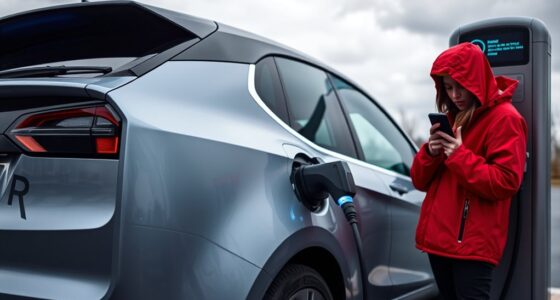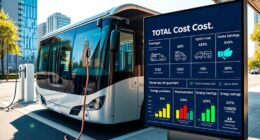Switching from diesel to electric vehicles can lower your fuel and maintenance costs markedly, but it also requires planning for new challenges like establishing charging infrastructure and adjusting route schedules. You’ll find that electric trucks often reduce repair expenses and provide more predictable operating costs. While the initial investment might seem high, the long-term savings and operational efficiencies make the switch worthwhile. Discover more insights that can help you make a seamless transition and optimize your fleet.
Key Takeaways
- Charging infrastructure requires significant investment but reduces operational concerns over time as networks expand.
- EVs have higher upfront costs but lower maintenance and fuel expenses improve total cost of ownership.
- Electric vehicles offer more predictable operating costs due to stable electricity prices versus fluctuating diesel prices.
- Maintenance savings in EVs stem from fewer moving parts and regenerative braking, decreasing repair frequency and costs.
- Availability of charging stations along routes influences route planning; infrastructure expansion enhances operational efficiency.

As fleet managers evaluate their options, the choice between diesel and electric vehicles becomes increasingly critical. You need to contemplate not just the initial purchase price but also the ongoing operating costs and logistics. One of the most significant factors in this decision is the charging infrastructure necessary for electric vehicles. Unlike diesel trucks, which can refuel quickly at existing gas stations, electric vehicles require dedicated charging stations. Setting up and maintaining this infrastructure can be a substantial upfront investment. You’ll need to assess whether your current facilities can support fast charging or if new installations are necessary, which could involve significant planning and costs. The availability of charging stations along your routes also impacts operational efficiency. If charging points are sparse, it may lead to longer downtimes or require rerouting, affecting delivery schedules and customer satisfaction. On the other hand, as charging networks expand, this concern diminishes, making EVs more practical for a broader range of operations. Additionally, the total cost of ownership analysis should include potential incentives and rebates for electric vehicle infrastructure. Maintenance costs form another critical aspect of your evaluation. Diesel engines, while proven and reliable, tend to have higher maintenance costs over their lifespan. They require regular oil changes, filter replacements, and more frequent repairs due to their moving parts and complex systems. Electric vehicles, however, have far fewer moving parts, resulting in lower maintenance needs and costs. You won’t need oil changes or exhaust system repairs, and regenerative braking systems reduce wear on brake components, further decreasing expenses. Over time, these savings can offset the higher initial purchase price of EVs. Still, you should also consider the availability of qualified technicians and parts for electric vehicles, especially if you operate in areas where EV service infrastructure is still developing. Furthermore, the ongoing costs of operating electric vehicles tend to be more predictable, thanks to lower fuel expenses and fewer unexpected repairs. Electricity is generally cheaper than diesel fuel, and you can often take advantage of off-peak charging rates to reduce costs further. In contrast, diesel prices fluctuate based on global markets, which can introduce uncertainty into your budgeting. When comparing these two options, don’t overlook the importance of total cost of ownership over the vehicle’s lifespan. While EVs might have higher upfront costs, their lower maintenance and fuel expenses can lead to substantial savings in the long run.
Frequently Asked Questions
What Are the Long-Term Cost Differences Between Diesel and Electric Fleets?
You’ll find that electric fleets often have lower long-term costs due to reduced fuel expenses and maintenance, but consider fuel tax implications, which may favor diesel. Resale value for electric vehicles is improving as demand rises, though diesel trucks might still hold more immediate resale value. Over time, electric fleets tend to be more cost-effective, especially with incentives and declining battery costs, making them a smarter investment for the future.
How Do Maintenance Requirements Vary Between Diesel and Electric Vehicles?
Think of electric vehicles as the wise owl, requiring less frequent maintenance than diesel counterparts. You’ll find fewer moving parts, reducing brake and engine repairs, and battery lifecycle management is key. Electric vehicles emit no tailpipe emissions, so their emissions impact is markedly lower. Regular checks on batteries and electrical systems replace oil changes and engine tune-ups, making maintenance simpler and more predictable, saving you time and money long-term.
What Are the Challenges of Charging Infrastructure for Electric Fleet Vehicles?
You face challenges with charging infrastructure, especially with securing enough charging stations to meet your fleet’s needs. Limited charging stations can cause delays, and you might worry about grid capacity, which may struggle to support multiple fast chargers simultaneously. Upgrading the grid or installing more stations necessitates significant planning and investment. Balancing station availability with grid capacity is essential to ensure your electric fleet runs smoothly and efficiently.
How Do Diesel and Electric Vehicles Perform in Extreme Weather Conditions?
Like a snowstorm tests a car’s resilience, extreme weather challenges your vehicles. Diesel engines usually perform reliably, but electric vehicles can struggle with battery performance in cold or hot conditions. Thermal regulation becomes essential to maintain efficiency. In extreme cold, batteries may lose capacity, while heat can cause overheating. Proper thermal management systems help electric vehicles adapt, ensuring consistent performance even in harsh weather.
What Are the Safety Considerations Unique to Electric Fleet Vehicles?
You should prioritize battery safety by regularly inspecting electric fleet vehicles for damage or wear, and guarantee proper handling during maintenance to prevent short circuits or fires. Emergency protocols are essential; familiarize yourself with procedures for battery fires or electrical failures, such as using appropriate extinguishers and safe evacuation steps. By staying vigilant and prepared, you can keep your fleet safe and respond effectively to any electric-specific incidents.
Conclusion
As you weigh diesel’s rugged roar against electric’s quiet hum, you feel the shift in your hands—one engine’s grit, the other’s gentle whisper. The road ahead glows brighter with innovation, each mile revealing smoother, cleaner journeys. Moving forward isn’t just about engines; it’s about embracing a future where your fleet moves silently through a cleaner sky, leaving behind the echoes of yesterday’s diesel and stepping confidently into a brighter, electric horizon.









